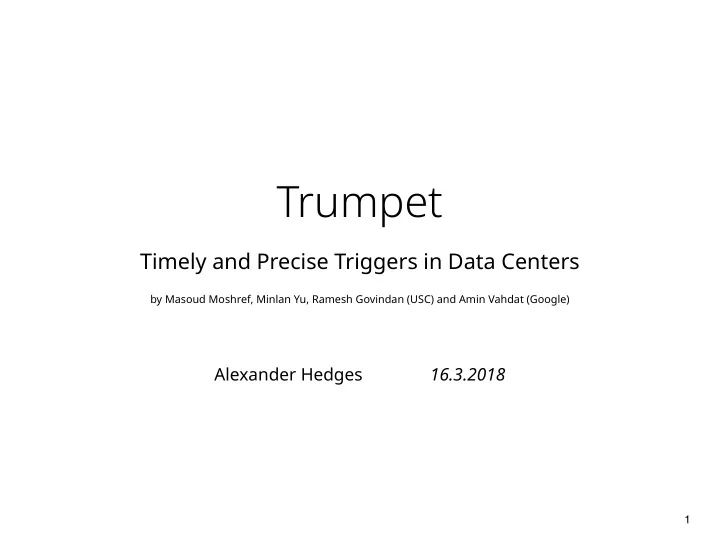

Trumpet Timely and Precise Triggers in Data Centers by Masoud Moshref, Minlan Yu, Ramesh Govindan (USC) and Amin Vahdat (Google) Alexander Hedges 16.3.2018 1
Why Monitoring? • Know how much to bill the customer • Detect attacks and failures • Detect unbalanced loads • Determine causes of congestion • If done on short timescales can be even more useful 2
Main ideas of the paper • Count every packet This can be achieved by moving the monitoring to the end host The endhost has to process the packet anyway • Automated response on short timescales • The two are coupled: Making the collection period short decreases memory requirements, counting every packet makes the automatic triggers more useful 3
Setup • Packet counting is done at the end host before they enter the vm • The controller configures the end hosts and is notified when the events take place 4
Events • An event is defined by a packet fi lter and a predicate • The packet filter specifies the type of packets (flows) that count towards the event Can be specified in a variety of ways (5-tuple, DstIp/24 etc.) • The predicate specifies the condition at which an action should be triggered Allows operations such as min, max, etc. 5
Trumpet Packet Monitor (on the End Host) • Needs to match the packet and evaluate the predicate at the end of the time interval • The naive implementations of either matching the packet on arrival or when evaluating the predicate don’t perform sufficiently well • For this reason the TPM first matches each packet to its flow and in the second phase collects the relevant packets and computes the predicate 6
TPM - Optimizations • Maintains an extra index to map from 5-tuples to triggers • Uses buffering to be able to interleave accepting packets with doing the gathering sweeps • Uses prefixing to increase cache coherence • And a few more • To not collapse under DoS attacks, very small flows are ignored when unfinished sweeps are detected 7
Trumpet Event Manager (Controller) • It installs the necessary triggers on the TPMs • Upon receiving a satisfaction message from the TPM it queries other hosts to check if the event really occurred • Some triggers can also be installed conditionally as responses to events 8
Evaluation • Running simulated network traffic on a 40G NIC: No packet was dropped * * The minimum packet size for 40G was 650 bytes and the minimum time granularity was 10ms • Most optimizations were vital to not dropping packets • Resource usage is proportional to the traffic rate and the monitored traffic rate 9
Evaluation (continued) • The packet processing time increases linearly with the amount of patterns to match • The authors determined a feasability region for their configuration: Feasibility region The different lines denote time intervals (in ms). The tests are for 300 (first image) 600 (second image) flows. • They also tested trumpet under attack loads (see next slides) 10
Evaluation - Pictures Sweep and quiescent time Sweep time linearly increases with percentage of matched packages irrespective of load. CPU idle time decreases with increased packet througput. Trigger matching preformance Matching is almost independent of trigger amount but depends on the amount of patterns. The packet matching times are proportional to the amount of patterns. DoS threshold Blue is a syn attack (attacks phase 1). Green is a threshold attack (attacks phase 2). Trumpet is fairly good at estimating its own performance. 11
Conclusion and Outlook • The paper shows the realization of per packet network monitoring • It demonstrates the use of automated responses to network events • To scale beyond 40G or very small packets TPMs can be run on different cores and there can be "local" TEMs to bundle requests • The paper also proposes sharding to increase TEM performance 12
My 2 cents • Very readable paper • Paper strikes nice balance between new ideas and optimization • The results don’t make any comparisons to other systems • One should note that this solution is specific to data centers where the hosts are under the control of the data center owner 13
Thank you 14
Recommend
More recommend